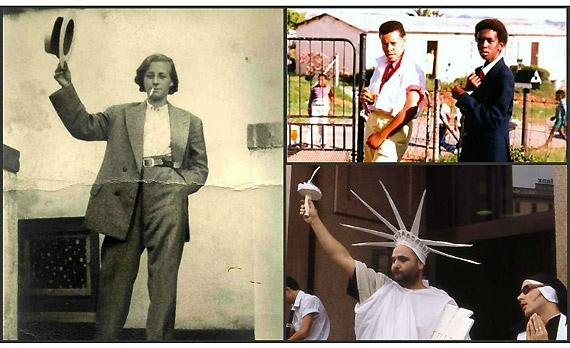Three Questions for Curator E.G. Crichton
Press release by The GLBT Historical Society & The GLBT History Museum, USA

The “Migrating Archives” exhibition will feature materials from nine countries, including Belgium (left), South Africa (upper right) and Italy (lower right).
Exhibition Opening: February 1, 6 – 8 p.m.
Migrating Archives: LGBT Delegates From Collections Around the World
at The GLBT History Museum, San Francisco, USA
Creating a Welcome for Migrating Archives
A new exhibition opening on February 1 at The GLBT History Museum draws on innovative curatorial work combining art and history to offer a glimpse into both the stories of archival organizations and the ways they document queer lives. Conceived by E.G. Crichton, the museum’s artist-in-residence, Migrating Archives: LGBT Delegates From Collections Around the World features materials from Australia, Belgium, England, Hungary, Italy, the Netherlands, the Philippines, Scotland, South Africa and the United States. Crichton is a professor of art at the University of California, Santa Cruz, whose work has been widely exhibited. She recently responded to questions from History Happens.
As an artist, what curatorial vision did you bring to the exhibition?
For years now, no matter what subject I’ve explored as an artist, I can’t resist bringing historical research into the mix. Working intensely with the archives at the GLBT Historical Society made me curious about other archives with queer materials. When ILHIA, the GLBT history organization in Amsterdam, decided to hold a conference last summer, I knew I had to go – and that I wanted to imagine a project that would foster relationships between collections around the world. This became the first version of Migrating Archives, an exhibition at the beautiful central library in Amsterdam. The way that people embraced crossing borders to display the history of GLBT lives and archives made me realize I wanted to bring some of the stories back to San Francisco. I consider the archives in the current exhibition to be honored guests of The GLBT History Museum.
What do you mean when you describe collections as “migrating archives”?
Most of the time, archives sit on shelves, waiting for the occasional researcher. But as an artist, I’ve found myself wanting to set them in motion. This has sometimes meant matching a collection to an artist and asking the artist to invent a response. The responses form new kinds of archives that reside in exhibitions and presentations – and in suitcases that I’ve taken to other countries. I started to think of these as archives that wander. For this show, I wanted to reverse the direction of travel by inviting organizations to send “delegates” – individual archives that represent their larger holdings in some way. The participants have been surprisingly trusting and generous: They’ve sent digital files, CDs, texts, and even created videos for this show. The archives have traveled from nine different countries in the forms that stories can migrate in the digital age.
What can we learn from the life stories highlighted in the show?
As diverse as the archives and organizations are, I’m struck by how familiar the stories seem. Some represent famous or infamous people from over a century ago: Oscar Wilde’s petition to the court from 1896 or a document from 1891 noting that an individual convicted of sodomy “committed suicide by taking poison in the prison cell passage immediately after sentencing.” Others seem more like us, now: Monte Punshon, who came out at the age of 103 in Australia; Beverly Ditsie, an activist lesbian in South Africa; Sándor/Sarolta Vay who lived as a man in Hungary; Stefano Casagrande, who died of AIDS in Italy. Their lives are fascinating in their own right, and they take us outside our local world to make imaginative connections with queer communities in other times and places.